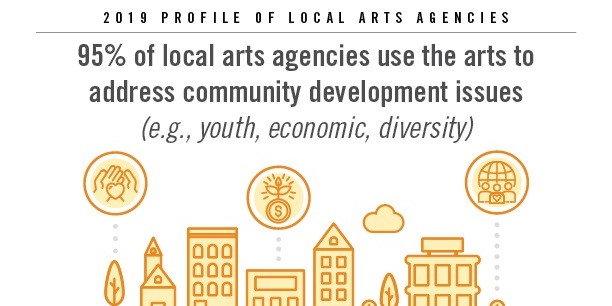
Ninety-one percent of all local arts agencies (LAAs) in the United States have at least one partnership. It is one of the most prevalent and consistent strategies for LAAs to expand their influence and address community issues. A just-released study from Americans for the Arts, available as part of the 2019 Local Arts Agency Profile, dives into how, when, and where LAAs in the United States enter partnerships with for-profit businesses, government or public sector entities, and non-arts nonprofits. Overall, it indicates that while almost all LAAs enter partnerships, the alchemy of pursuing, setting, and sustaining those partnerships varies. At the same time, with a few marked exceptions, the goals that the LAAs and their partners are pursuing in those partnerships are relatively stable, regardless of the type of partner involved.
Here are some of the top findings of the report:
Entering partnerships: 91% of all LAA respondents have entered a formal or informal partnership with either a for-profit business, a non-arts government/public entity, or a non-arts nonprofit in the last four years. More than half have partnerships in more than one category.
Partnering to impact non-arts areas: Ninety-five percent of all LAA respondents are currently involved in addressing at least one non-arts issue. Top issues include tourism, youth development, community development, economic development, and planning.
Barriers to partnership: The most dominant reason an LAA could not pursue a partnership was staff capacity or time; the next most common barrier was money.
Formality of partnership documentation: While about a third of LAA respondents document partnership structure in some way, almost half have no written agreement.
Top goals for partnerships: The goals of partnerships for LAAs were: getting broader visibility for the arts, getting financial support for the LAA, getting visibility for the LAA, getting non-financial resources, and getting expertise. For the non-LAA partner, the goals were: giving visibility to their organization, getting broader visibility for the arts, giving financial support to the LAA, improving the lives of their employees, and getting expertise.
Resource, risk, and impact allocations: In almost half of partnerships, the financial risk is taken on by both partners—although the non-LAA partner is more likely to provide financial investment, and the LAA partner is more likely to provide staff time and human capital. The ROI on partnerships for LAAs generally is good—they tend to report accruing more of the financial and staff/capital outcomes than the non-LAA partner, or at the very least are likely to say that they and the partner accrued impact evenly.
Evaluating partnership effectiveness: Eighty-four percent of LAA respondents indicate that they do some level of evaluation of their partnerships. Of that group, just under half compare outcomes to original stated goals and/or seek input from the non-LAA partner about effectiveness. About a third of respondents look at community-level indicators and/or conduct informal surveying of stakeholders.
Metrics for success: The most prevalent success metric for partnerships is impact on the broader constituency and/or community. About 4-in-10 review the financial impact or non-financial impact on the LAA, and a similar number review the non-financial impact on the non-LAA partner.
Collectively, LAA partnerships are a common and useful technique for expanding the impact and influence of LAAs, particularly in efforts to address non-arts issue areas in the community. They tend towards collaborations where the LAA is providing human capital and the non-LAA partner is providing financial support. These partnerships tend to be documented, although that documentation can vary in its formality and is relatively rarely legally binding. Documenting the structure of, and evaluating, these partnerships is generally something that occurs and that is often driven by the LAA partner. The goals for partnerships vary between the partners, but in the best circumstances they resonate with each other—allowing both risk and reward to be distributed and appropriate between partners.

Be the first to comment